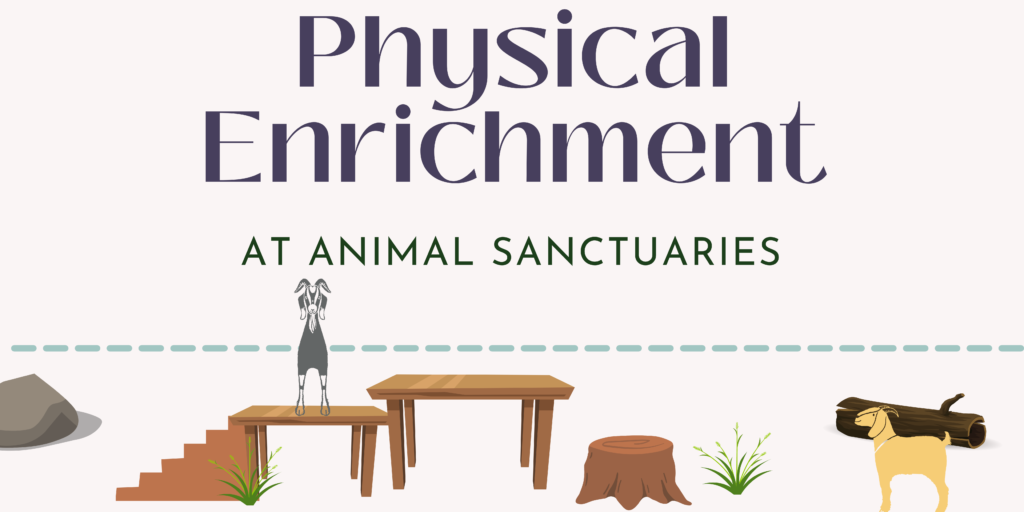
Providing dynamic living spaces that cater to residents’ natural behavioral needs is a valuable way to improve and help ensure continued well-being. Physical (or structural) enrichment provides or designs physical elements in living spaces that encourage natural behaviors. Keeping residents engaged and interacting with their environment goes beyond adding toys or tasty treats, though both are good examples of other types of enrichment. Previously, in our “Time To Thrive” series, we covered the categories of enrichment. This resource will examine how physical enrichment, additions, alterations, and site locations, can benefit residents. Some of this will sound familiar if you have read our animal-centered design resource! If you haven’t, it’s a great resource to check out, and ties in with this information well. Let’s get started!
Physical Enrichment
This form of enrichment considers the individual’s environment, what aspects of the current environment meet behavioral needs, and what can be added to the living spaceThe indoor or outdoor area where an animal resident lives, eats, and rests. to make it more dynamic, encouraging natural behavior and exploration. Donkeys, for example, might thrive more in a physical environment with multiple dust bathing areas, food and water areas, large rocks, tree stumps or downed trees (donkey-safe), mounds, or other elevated structures for standing upon and getting a different view of their environment. Of course, physical enrichment looks different for every species (and can vary greatly among individuals too). Take ducksUnless explicitly mentioned, we are referring to domesticated duck breeds, not wild ducks, who may have unique needs not covered by this resource., on the other hand, who require different environmental aspects to thrive. This might look like providing an environment with copious nesting materials, multiple water features, and duck-safe bushes and grasses.
Highly Pathogenic Avian Influenza And Bird Residents
Due to the growing prevalence of HPAI, it is not recommended to allow bird residents access to water or resources to which wild birds have access. Learn more about how you can protect bird residents here.
Enrichment Overlap
As we cover physical enrichment, you will notice there will be an overlap in sensory enrichment and even nutritional and social enrichment. (If you are unfamiliar with enrichment, check out this introductory resource.) An example of overlapping enrichment categories may be giving goat residents access to living spaces with goat-safe trees and shrubs in their outdoor living spaces. (You may find you have to protect the trees from over-exuberant snacking residents!) This provides nutritional enrichment and sensory enrichment, as well as physical enrichment.
Let’s look more closely at how a resident may experience physical enrichment:
A Resident’s Experience
Imagine you are Imogene, a goat resident. You have a daily routine where you eat grain and hay provided by caregivers in the morning; then you spend the rest of your day…..doing what? Maybe snack on some plants in the pasture or eat more hay. (Goats should spend a good deal of time eating throughout the day.) If you have species-appropriate physical enrichment in your living space, you might climb up some rocks or jump off platforms of various sizes placed around your living space. Maybe you take a nice rest under a platform or tree and enjoy the shade and a little quiet time away from a tour taking place in the distance. After a nice rest, you look up and around, noticing different elements of your environment to take in. You can’t see around those large wooden spools (be sure the hole in the middle is covered!), but you can hear two kids on the other side playfully butting heads. You climb up a mound of packed dirt nearby to get a better look at your surroundings and see Bertie, your buddy, snacking on some browse hung from an old tree. Interesting! You hop down and scramble over a few large rocks to join her. Later that night, when you all go indoors to sleep, you choose a platform of medium height upon which to rest. As time goes by, new spools, dirt mounds, and tree stumps are brought in or moved around, and snacks and new scents are spread around your living space, making your days new and interesting.
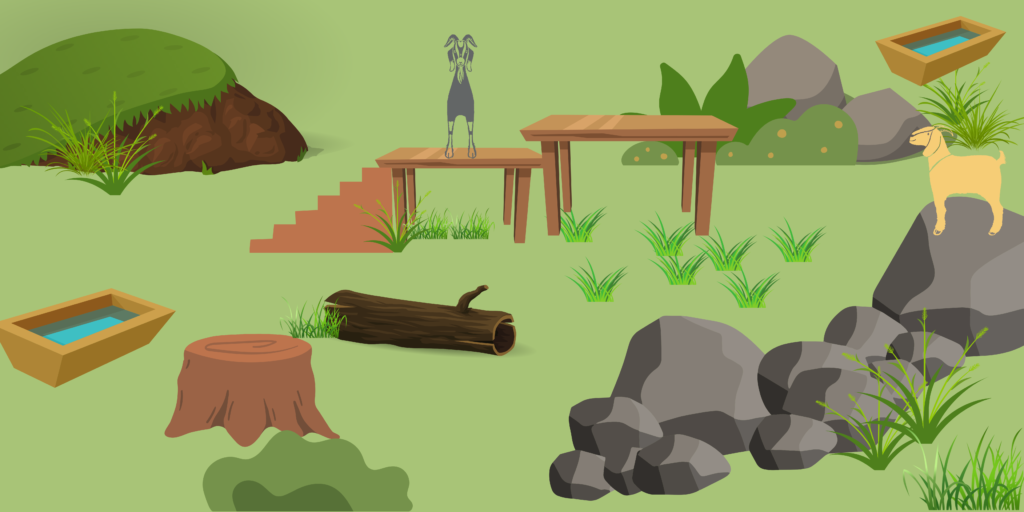
Now imagine that same scenario, except after eating your breakfast, you look out on a small flat field that, aside from some sparse grass and a few bushes, is bare. You stick near your indoor space because it offers better shade. It is pretty warm out, and after a bit, your caregiverSomeone who provides daily care, specifically for animal residents at an animal sanctuary, shelter, or rescue., Angie, comes out with some nutritional enrichment which you dig right into. That is soon gone, but the smell, look, feel, and taste of the produce in the ice block was engaging. Little changes in this flat outdoor living space, and there isn’t anything new for you to explore or engage with. You hang out with your buddies snacking on hay. The next day looks much the same. Other forms of enrichment are brought in, mostly nutritional, but none that make you feel like jumping, climbing, standing on your hind legs, or exploring.
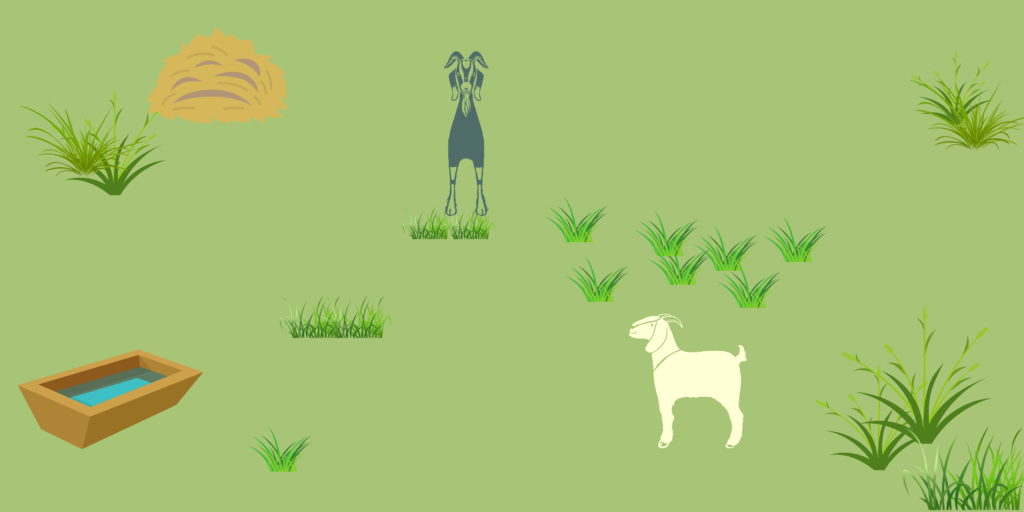
As the above scenarios show, while it is possible to still provide interesting experiences for goat residents, an engaging physical environment that encourages natural behaviors can help ensure the well-being of residents. Even if both scenarios include regular nutritional, sensory, cognitive, or social enrichment, providing the living space for residents to meet their behavioral needs makes a big difference. When a resident’s needs are unmet, this can have negative physical and psychological effects. Implementing enrichment as part of general care can help residents truly thrive. And what better place to start than providing environmental elements that each species is likely to find most engaging, encouraging them to perform natural behaviors? Physical enrichment can involve both natural and constructed elements. Let’s take a look at some examples of both.
Remember The Individual
Always keep the individual in mind when brainstorming physical enrichment ideas! Age, mobility, health status, breed, and personality can all affect how a resident might safely engage with different enrichment elements.
Topography
Topography is the landscape around you. It includes formations such as mountains and valleys, textures like sandy, rocky deserts or open flat grasslands, and elevation. Why is it important to consider the topography? Because a natural environment will allow residents to behave more naturally, helping to fulfill their behavioral needs.
When looking at a living space or potential site location, ask yourself: Is this their or their ancestor’s natural environment or something akin to it? Are there ways we can design their space to mimic this environment better?
Alternatives To Natural Topography
Your sanctuary may be in an area lacking some or all of the topography in which certain resident species generally thrive. That’s okay! There are many ways you can add elements. Some of these elements are as simple, natural, and inexpensive as a big pile of packed dirt, an old tree, logs, bushes, leaves, tall grasses, rocks, or branches. While providing a natural environment for residents is wonderful, this isn’t always possible. Moving boulders probably isn’t feasible for most! However, physical enrichment doesn’t have to be “natural.” Ladders can provide chicken residents (generally not appropriate for large breed chickens) with favored roosting areas, and adding wooden platforms and stairs can be great for goats. Tops from old brooms or street sweeper brushes can become great scratching posts when secured safely to a post. Kiddie pools and misters can be provided to residents who enjoy swimming or cooling off. Visual barriers and shelter can be provided through the use of shade tarps and shade structures.
Consider:
- Water features (streams, ponds, pools, fountains, misters) NOTE: There can be safety issues associated with ponds and other bodies of water, such as a resident getting stuck, falling through ice, toxic algae, disease transmission, and wildlife. Be sure to consider the risks carefully and close off the area if these dangers are a concern.
- Substrate (sand, dirt, rocks, grass, mud, leaves)
- Flora (grassland, trees, shrubs, bushes, plants)
- Large topographical elements (boulders, outcroppings, low valleys, flat spaces, mounds)
- Visuals (clear, open spaces or lots of elements breaking up the horizon)
- Natural shelters and hiding places (outcroppings, trees, tall grass, bushes)
- Nesting material (twigs, branches, grass, straw, leaves)
- Climate (wind, humidity, light, temperature)
Species-Specific Physical Enrichment: Visual Inspiration
Now that we’ve looked at general concepts of physical enrichment, let’s look at some visual examples of how this might look for different species. You can also check out the links below to read tips about physical and other forms of enrichment for different species. Learning as much as possible about the species will help you develop successful enrichment strategies.
Alpacas
Let’s look at some alpaca-specific physical enrichment:
- Provide multiple water and food “stations”.
- Provide nice dusty or sandy spots for a good roll in the dirt. Be careful not to feed residents on sand as they could ingest it, causing an impaction.
- Add new features to their environment on a schedule.
- Vary the terrain; a mound of dirt or hill can provide an interesting element for residents.
- Practice rotational grazing, which allows them access to new areas.
- Provide a wading pool or misters.
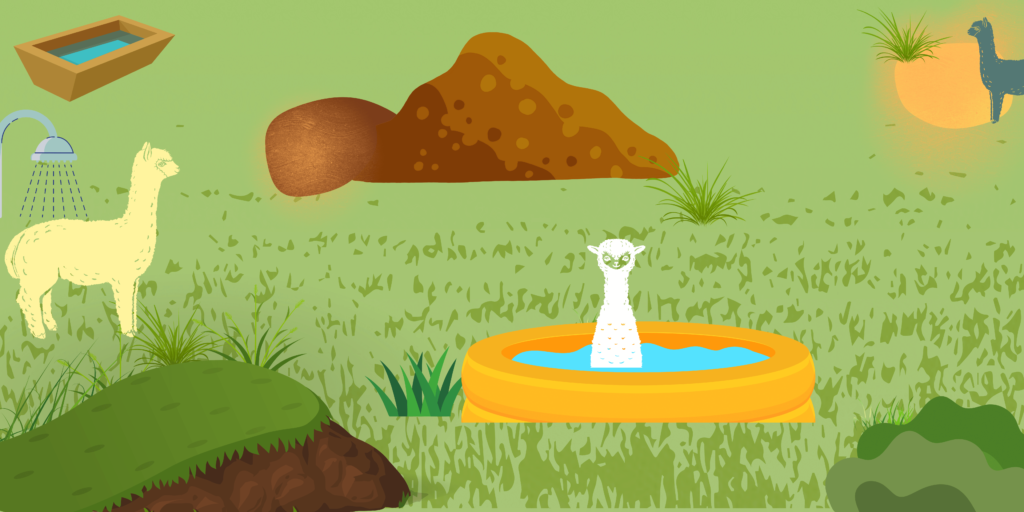
Chickens
Let’s look at some chicken-specific physical enrichment. (When providing enrichment for chicken residents, be sure you following HPAI biosecurity guidelines)
- Add stumps, ramps, and ladders all provide different opportunities to perch and explore.
- Cover some overhead areas to provide a sense of safety and shade to more comfortably allow exploration of the living space.
- Add and secure branches for perches.
- Try out swings and more complex furniture (keeping in mind the needs of the individual).
- Add little curtains to nesting boxes to allow the option for privacy.
- Break up the living space with shrubs, bushes, and grasses.
- Add dirt for nice dust-bathing opportunities.
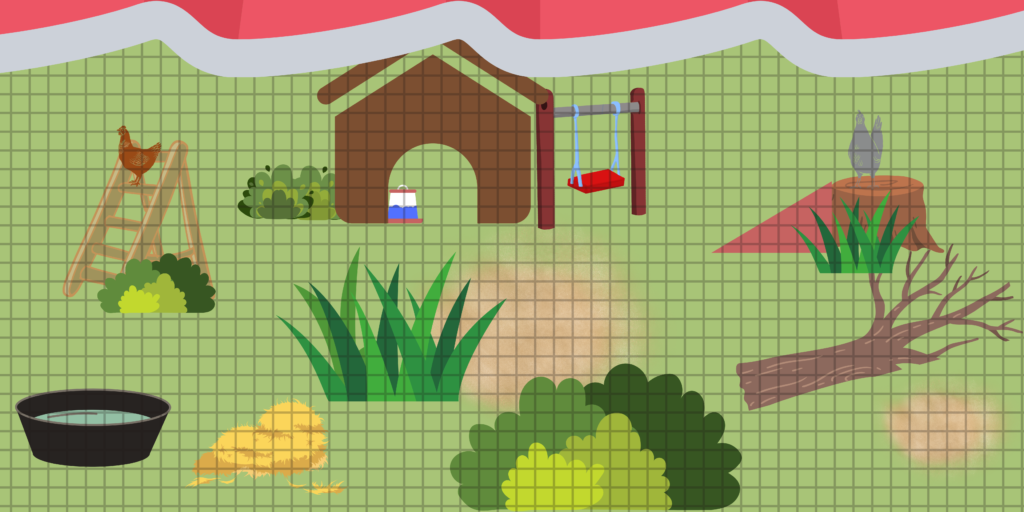
Cows
Let’s look at some cow-specific physical enrichment:
- Provide multiple water and food “stations.”
- Provide different piles of substrate like dirt or leaves or mulch (cow-safe).
- Set up self-grooming stations.
- Set up a “trail” using moveable, temporary fencing to encourage them to use their outdoor living space to get to certain high-value grazing spots. This can also encourage them to run with their companions, so it’s important to ensure spacing is wide enough so no one feels trapped.
- If you have access to wooded areas (ensure everything is cow-safe), these can make wonderful parts of outdoor living spaces for cowWhile "cow" can be defined to refer exclusively to female cattle, at The Open Sanctuary Project we refer to domesticated cattle of all ages and sexes as "cows." residents.
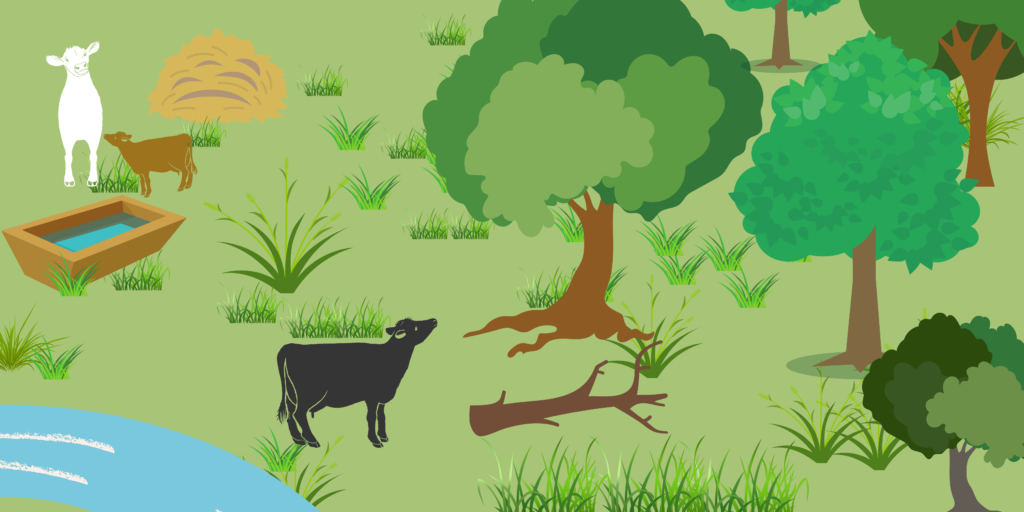
Donkeys
Let’s look at some donkey-specific physical enrichment:
- Provide multiple water and food “stations.”
- Provide nice dusty or sandy spots for a good roll in the dirt. Be careful not to feed residents on the sand as they could ingest it, causing an impaction.
- Set up self-grooming stations.
- Set up a “trail” using moveable, temporary fencing to encourage them to use their outdoor living space to get to certain high-value grazing spots. It’s important to ensure spacing is wide enough, so no one feels trapped.
- Put rocks, stumps, downed trees (ensure everything is donkey-safe), dirt mounds, and even human-made structures such as little platforms around their outdoor living spaces.
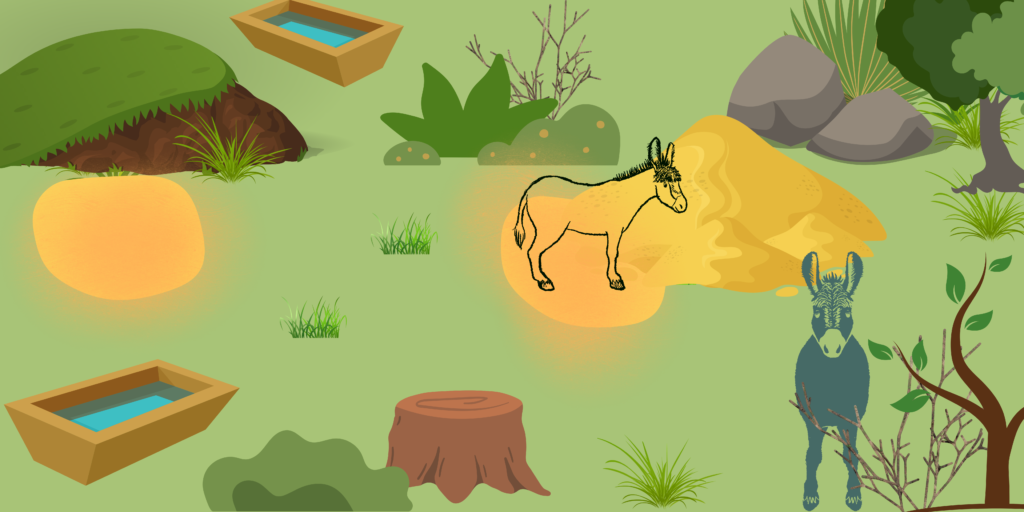
Ducks
Let’s look at some duck-specific physical enrichment:
- Provide multiple water and food “stations.”
- Provide nice grassy areas, bushes, and duck-safe plants.
- Offer multiple nesting materials and substrates like straw, leaves, and even fresh piles of dirt of duck-safe mulch.
- Set up temporary fencing in a way that encourages them to make use of their outdoor living space and allow access to other areas on a schedule
- Ensure they have access to a pool, puddle, safe pond, and other water features.
(When providing enrichment for duckUnless explicitly mentioned, we are referring to domesticated duck breeds, not wild ducks, who may have unique needs not covered by this resource. residents, be sure you following HPAI biosecurity guidelines)
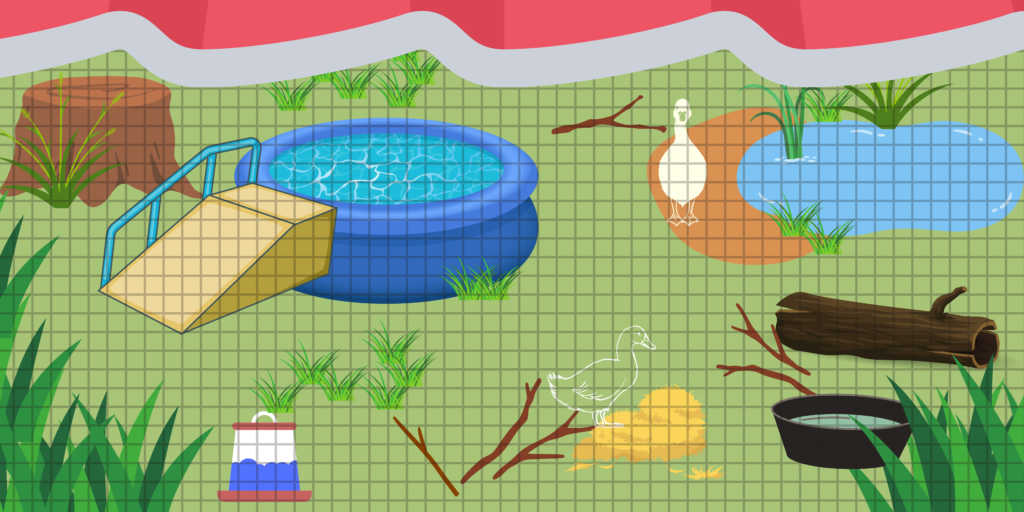
Geese
Let’s look at some goose-specific physical enrichment:
- Provide multiple water and food “stations.”
- Provide nice grassy areas, bushes, and other duck-safe plants.
- Offer multiple nesting materials and substrates like straw, leaves, and even fresh piles of dirt of goose-safe mulch.
- Set up temporary fencing in a way that encourages them to make use of their outdoor living space and allow access to other areas on a schedule
- Ensure they have access to a pool, puddle, safe pond, and other water features.
(When providing enrichment for gooseUnless explicitly mentioned, we are referring to domesticated goose breeds, not wild geese, who may have unique needs not covered by this resource. residents, be sure you follow HPAI biosecurity guidelines)
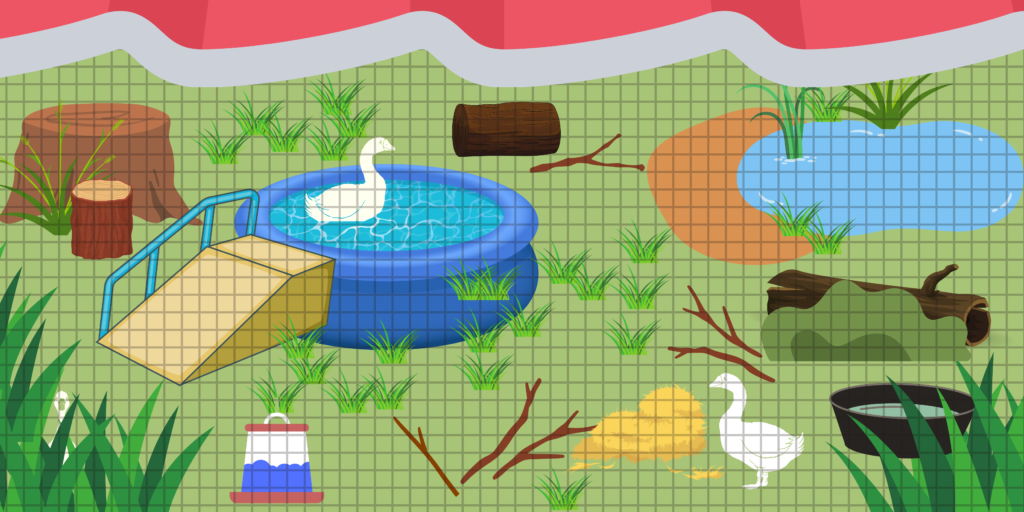
Goats
Let’s look at some goat-specific physical enrichment:
- Provide multiple water and food “stations.”
- Provide different piles of substrate like fresh dirt, piles of leaves, or goat-safe mulch.
- Mounds, old trees, goat-safe bushes etc…
- Set up self-grooming stations.
- Rock features to climb upon.
- Provide stumps, large rocks, large spools (be sure the hole in the middle is covered!), and wooden platforms to allow climbing behavior.
- Partition their outdoor living space and rotate where they have access.
- Add new features to their environment on a schedule.
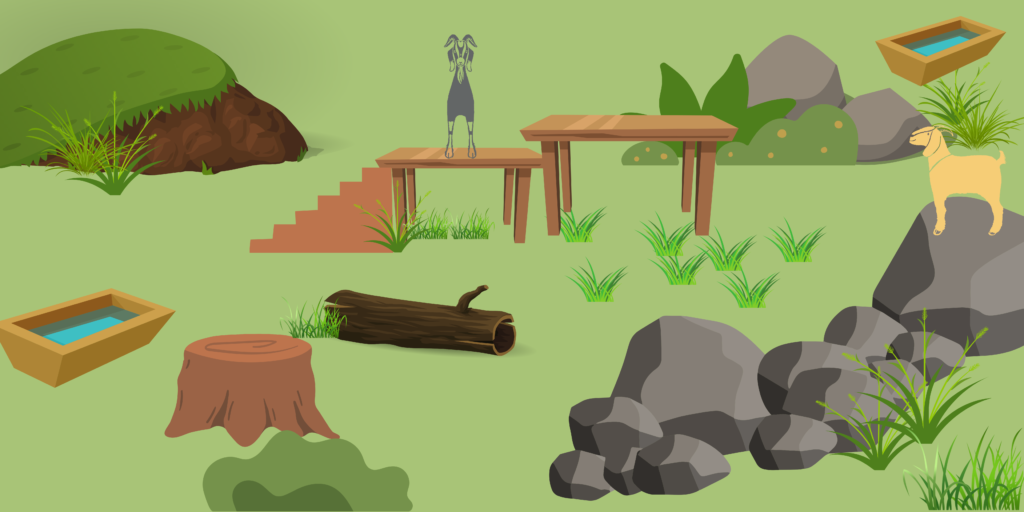
Horses
- Providing multiple water and food “stations”.
- Provide nice dusty or sandy spots for a good roll in the dirt. Be careful not to feed residents on sand as they could ingest it, causing an impaction.
- Set up self grooming stations.
- Set up a “trail” using moveable, temporary fencing in a way that encourages them to make use of their outdoor living space to get to certain high value grazing spots. This can also encourage them to run with their companions, so it’s important to ensure spacing is wide enough so no one feels trapped.
- Add new features to their environment on a schedule.
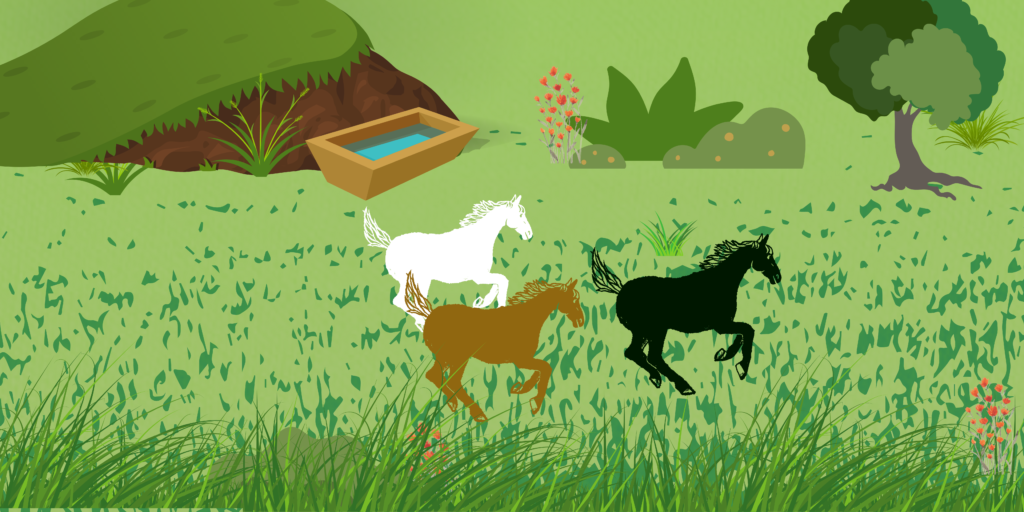
Llamas
Let’s look at some llama-specific physical enrichment:
- Provide multiple water and food “stations.”
- Provide nice dusty or sandy spots for a good roll in the dirt. Be careful not to feed residents on sand as they could ingest it, causing an impaction.
- Add new features to their environment on a schedule.
- Vary the terrain; a mound of dirt or hill can provide an interesting element for residents.
- Practice rotational grazing, which allows them access to new areas.
- Provide a wading pool or misters.
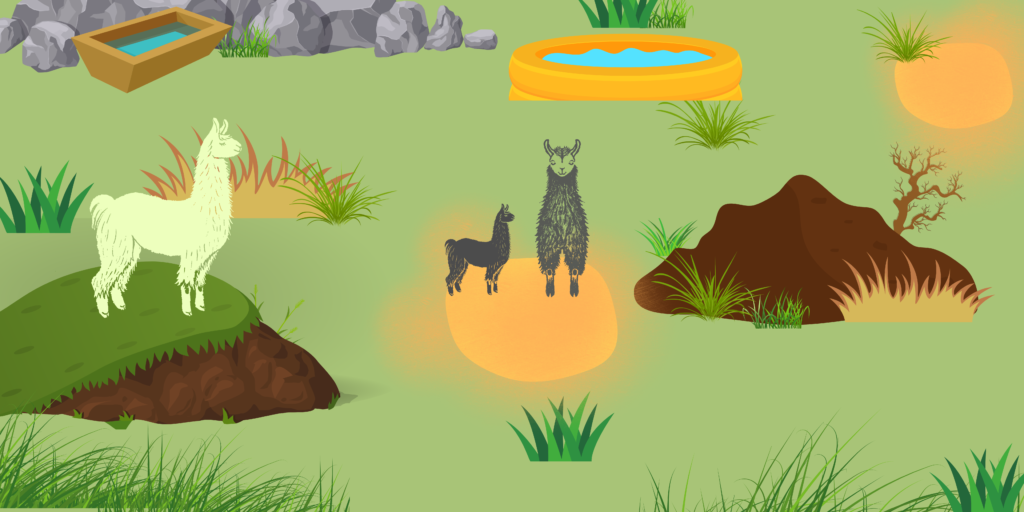
Pigs
Let’s look at some pig-specific physical enrichment:
- Provide multiple water and food “stations.”
- Provide different piles of substrate like fresh dirt, piles of leaves, or pig-safe mulch.
- Add a nice mud wallow!
- Set up self-grooming stations.
- Partition their outdoor living space and rotate where they have access to.
- Add pig-safe logs and old trees.
- Add new features to their environment on a schedule.
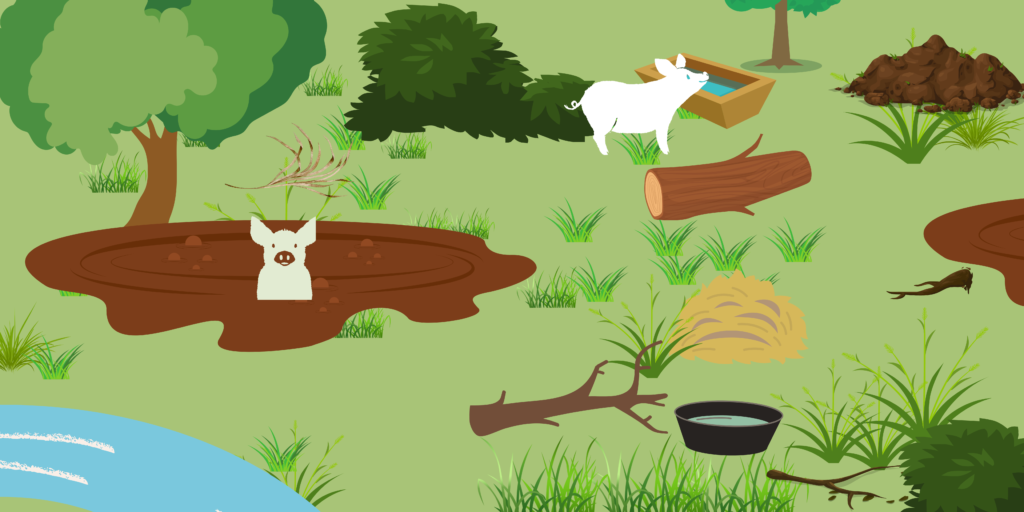
Rabbits
Let’s look at some rabbit-specific physical enrichment:
- Provide a dynamic rabbitUnless explicitly mentioned, we are referring to domesticated rabbit breeds, not wild rabbits, who may have unique needs not covered by this resource. hidey house that is one or multiple levels, with holes between floors for rabbit residents to explore.
- Hollow logs, large PVC tubing, cardboard carpet rolls, and collapsible tunnel toys all provide rabbit residents with places to hide and explore, similar to a wild rabbit’s warren.
- Cardboard boxes can be made into an edible castle or hidey hole! (Be sure always to create at least two entrances or exits, as this will help residents feel safer using them.)
- Platforms: RabbitsUnless explicitly mentioned, we are referring to domesticated rabbit breeds, not wild rabbits, who may have unique needs not covered by this resource. like to climb up on things and survey their surroundings. Including little platforms made out of sturdy wooden boxes, large rocks, stumps, stairs, or solid shelving placed around their living space helps create a dynamic environment.
- Areas with fresh dirt and sand can help provide rabbits with areas to dig. Be careful not to feed residents on sand as they could ingest it, causing an impaction.
- Similarly, a nice dusty spot allows rabbits to have a nice roll in a dust bath!

Sheep
Let’s look at some sheep-specific physical enrichment:
- Provide multiple water and food “stations.”
- Provide different piles of substrate like fresh dirt, piles of leaves, or sheep-safe mulch.
- Mounds, old trees, sheep-safe bushes etc…
- Set up self-grooming stations.
- Partition their outdoor living space and rotate where they have access to.
- Add new features to their environment on a schedule.
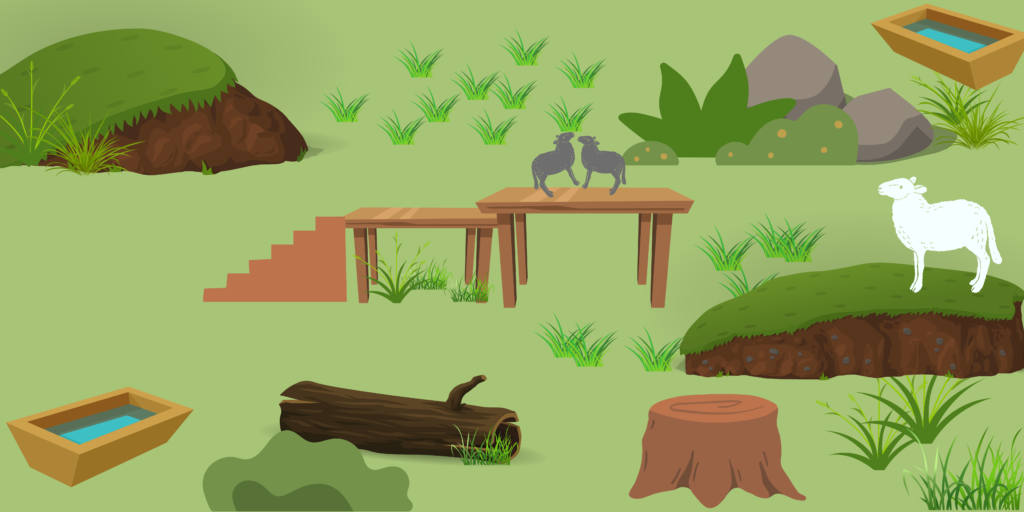
Turkeys
Let’s look at some turkey-specific physical enrichment:
- Add stumps, ramps, and ladders all provide different opportunities to perch and explore.
- Cover some overhead areas to provide a sense of safety and shade to more comfortably allow exploration of the living space.
- Add and secure branches for perches.
- Try out more complex furniture (keeping in mind the needs of the individual).
- Add little curtains to nesting boxes to allow the option for privacy.
- Break up the living space with shrubs, bushes, and grasses.
- Add dirt for nice dust-bathing opportunities.
(When providing enrichment for turkeyUnless explicitly mentioned, we are referring to domesticated turkey breeds, not wild turkeys, who may have unique needs not covered by this resource. residents, be sure you following HPAI biosecurity guidelines)

We hope this inspires you to devise creative ways to provide physical enrichment for your residents. Remember that physical enrichment strategies, and all other forms of enrichment, are only enriching if a resident finds it so. A resident who is bored, fearful, or upset at proffered enrichment is not having an enriching experience!
SOURCES:
The Stimulating Science Of Animal Enrichment | Untamed Science
Five Enrichment Categories | The Shape Of Enrichment
Guidelines For General Species Environmental Enrichment | NIH (Non-Compassionate Source)
Non-Compassionate Source?
If a source includes the (Non-Compassionate Source) tag, it means that we do not endorse that particular source’s views about animals, even if some of their insights are valuable from a care perspective. See a more detailed explanation here.








